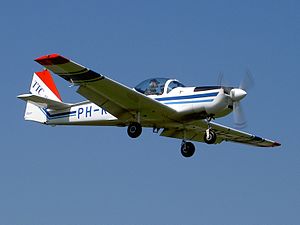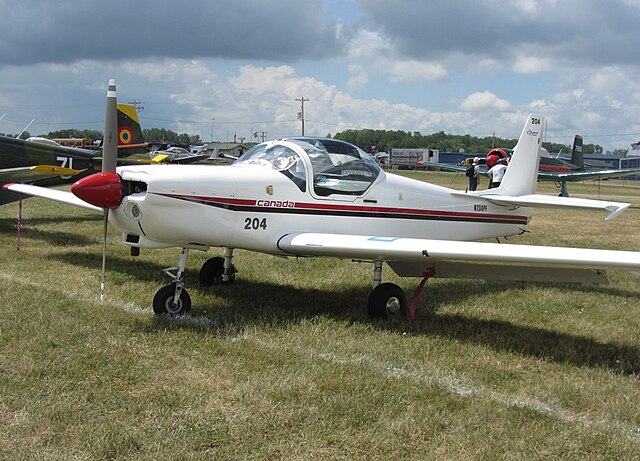Loading AI tools
Aerobatic training aircraft From Wikipedia, the free encyclopedia
The Slingsby T67 Firefly, originally produced as the Fournier RF-6, is a two-seat aerobatic training aircraft, built by Slingsby Aviation in Kirkbymoorside, Yorkshire, England.[1]
| RF-6, T67 Firefly | |
|---|---|
 Slingsby T67M260 Firefly | |
| General information | |
| Type | Trainer/tourer/sport aircraft |
| Manufacturer | Fournier Slingsby Aviation |
| Status | Limited Service |
| Primary users | Royal Jordanian Air Force |
| Number built | > 250 |
| History | |
| Manufactured | 1974–1995 |
| First flight | 12 March 1974 |
| Developed into | Sportavia RS-180 |
It has been used as a trainer aircraft by several armed forces, as well as civilian operators. In the mid-1990s, the aircraft became controversial in the United States after three fatal accidents during US Air Force training operations. The Firefly has poor spin recovery, and has been involved in at least 36 fatal accidents.[2]
The RF-6 was designed by René Fournier, and first flew on 12 March 1974. An all-wooden construction, it featured a high aspect-ratio wing echoing his earlier motorglider designs. Fournier set up his own factory at Nitray, near Tours to manufacture the design, but after only around 40 had been built, the exercise proved financially unviable, and he was forced to close down production. A four-seat version was under development by Sportavia-Pützer as the RF-6C, but this demonstrated serious stability problems that eventually led to an almost complete redesign as the Sportavia-Pützer RS 180 Sportsman.
In 1981, Fournier sold the development rights of the RF-6B to Slingsby Aviation, which renamed it the T67. The earliest examples, the T67A, were virtually identical to the Fournier-built aircraft, but the design was soon revised to replace the wooden structure with one of composite material. Slingsby produced several versions developing the airframe and adding progressively larger engines. The Slingsby T67M, aimed at the military (hence "M") training market, was the first to include a constant-speed propeller and inverted fuel and oil systems. Over 250 aircraft have been built, mainly the T67M260 and closely related T-3A variants.
The largest Firefly operator was the United States Air Force, where it was given the designation T-3A Firefly. The Firefly was selected in 1992 to replace the T-41 aircraft for the command's Enhanced Flight Screening Program, which would include aerobatic maneuvers. From 1993 to 1995, 113 aircraft were purchased and delivered to Hondo Municipal Airport in Texas, and the U.S. Air Force Academy in Colorado. The type was meant to not only replace the Cessna T-41 introductory trainer, but also to meet the Enhanced Flight Screening Program (EFSP) requirements. The Commander of the Air Education and Training Command stood down the entire T-3A fleet in July 1997 as a result of uncommanded engine stoppages during flight and ground operations. A major factor driving the decision were the three T-3A Class A mishaps. Three Air Force Academy cadets and three instructors were killed in these T-3A mishaps.[3] The US Air Force has no replacement for this type, as it no longer provides training to non-fliers.[clarification needed] The aircraft were eventually declared in excess of need in the early 2000s and disposed of by scrapping in 2006.[2][4]
The Royal Air Force used 22 Slingsby T67M260s as their basic trainer between 1995 and 2010. Over 100,000 flight hours were flown out of RAF Barkston Heath by Army, Royal Navy and Royal Marines students, and at RAF Church Fenton with RAF and foreign students.[citation needed]
The Firefly has also been used by the Royal Hong Kong Auxiliary Air Force,[citation needed] and the Royal Jordanian Air Force (still currently used).[when?][citation needed]
The Firefly was used in Britain for basic aerobatic training in the 2000s.[5] In December 2012, the National Flying Laboratory Centre at Cranfield University in the UK acquired a T67M260 to supplement its Scottish Aviation Bulldog aerobatic trainer for MSc student flight experience and training.[citation needed] As of 2019 the Firefly is used in UPRT courses.[6]




The Firefly is used by the Royal Netherlands Air Force during pilot selection which is contracted out to TTC at Seppe Airport.
The Firefly was used as a basic military training aircraft in Canada. The Canadian Fireflies entered service in 1992 replacing the CT 134 Musketeer. They were, in turn, replaced in 2006 by the German-made Grob G-120 when the contract ended. The aircraft were owned and operated by Bombardier Aerospace under contract to the Canadian Forces.[citation needed]
The Firefly was used as a basic military trainer in the United Kingdom until spring 2010, when they were replaced by Grob Tutor aircraft. The aircraft are owned and operated under contract by a civilian company on behalf of the military. In the UK, it was under a scheme known as "Contractor Owned Contractor Operated" (CoCo).[citation needed]
Data from Brassey's World Aircraft & Systems Directory.[13]
General characteristics
Performance
Aircraft of comparable role, configuration, and era
Seamless Wikipedia browsing. On steroids.
Every time you click a link to Wikipedia, Wiktionary or Wikiquote in your browser's search results, it will show the modern Wikiwand interface.
Wikiwand extension is a five stars, simple, with minimum permission required to keep your browsing private, safe and transparent.